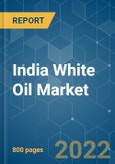The Indian white oil market was valued at 304,355.11 Kilo liters in 2021 in volume terms and is expected to register a CAGR of 1.69% during the forecast period (2022-2027).
White oils are highly refined mineral oils that are extremely pure, stable, colorless, odorless, non-toxic, and chemically inert. COVID-19 has significantly impacted India's white oil market, but it is expected to recover in the forecast period.
The Indian white oil market is consolidated in terms of volume. Some of the major market players (not in any particular order) include Savita OIl, Apar Industries Ltd., RAJ PETRO, Gandhar Oil and BPCL.
This product will be delivered within 2 business days.
White oils are highly refined mineral oils that are extremely pure, stable, colorless, odorless, non-toxic, and chemically inert. COVID-19 has significantly impacted India's white oil market, but it is expected to recover in the forecast period.
Key Highlights
- The improving lifestyle and growing demand for cosmetics are expected to drive the market. Also, considering a huge potential in the pharmaceutical industry, white oil finds a major application in the above industry.
- The availability of substitute products is likely to hinder the white oil market.
- The market opportunities include its possible usage in the food and beverage industry.
Key Market Trends
Pharmaceutical Industry Will Experience Significant Growth
- The pharmaceutical segment is the second-largest consumer of white oil. White oil is used in the production of laxative jellies, pomades, balms, creams, capsule lubricants, pelletizing aids, ointment bases, vaccines, etc.
- Pharmaceutical-grade white oil is used in this application segment as it has the highest degree of purity. The viscosity of white oil, ranging from light to medium, is used in pharmaceutical applications.
- According to the Government of India, the Indian pharma industry market size is expected to reach USD 130 billion by 2030. Furthermore, India has provided pharmaceutical products to more than 200 countries and may continue to do so in the future.
- India is the largest provider of generic drugs, which satisfies 40% of the generic drug demand in the United States and 30% of the United Kingdom. The domestic drug manufacturers consist of a chain of around 10,500 companies.
- Owing to the aforementioned factors, the demand for white oil will likely grow in the pharmaceutical application segment during the forecast period.
Plastics and Elastomers is Expected to Hold Significant Growth
- The plastics industry uses low-volatility white oils to produce plastics and various other polymers to improve and control the melt flow rate of the finished polymer to provide release properties or change the physical characteristics.
- White oils also play a vital role in the manufacture of thermoplastic elastomers. Elastomeric materials that can be processed without vulcanization use white oil as an extender to facilitate fabrication, particularly when light color or food approval is required. For this application, any of the Primol white oils can be helpful, depending on its particular function in the process.
- In Mar 2022, the Board of Supreme Petrochem approved Phase II expansion of its Expandable Polystyrene (EPS) plant at Nagothane, Maharashtra, by 30,000 MTA.
- Additionally, in 2021, LG Polymers India proposed to expand its polymer manufacturing capacity (inclusive of polystyrene) from 415 tons per day to 655 tons per day.
- Owing to all the aforementioned factors, the demand for white oil in plastics and elastomers applications will likely grow during the forecast period.
Competitive Landscape
The Indian white oil market is consolidated in terms of volume. Some of the major market players (not in any particular order) include Savita OIl, Apar Industries Ltd., RAJ PETRO, Gandhar Oil and BPCL.
Additional Benefits:
- The market estimate (ME) sheet in Excel format
- 3 months of analyst support
This product will be delivered within 2 business days.
Table of Contents
1 INTRODUCTION
4 MARKET DYNAMICS
5 MARKET SEGMENTATION
6 COMPETITIVE LANDSCAPE
7 MARKET OPPORTUNITIES AND FUTURE TRENDS
Companies Mentioned (Partial List)
A selection of companies mentioned in this report includes, but is not limited to:
- APAR Industries
- Bharat Petroleum Corporation Limited
- Columbia Petro Chem Pvt. Ltd?
- ExxonMobil Corporation
- Gandhar Oil Refinery (India) Limited
- H&R Group
- Raj Petro Specialities Pvt. Ltd
- RenkertOil
- Shell plc
- Sasol
- Savita Oil
Methodology

LOADING...










